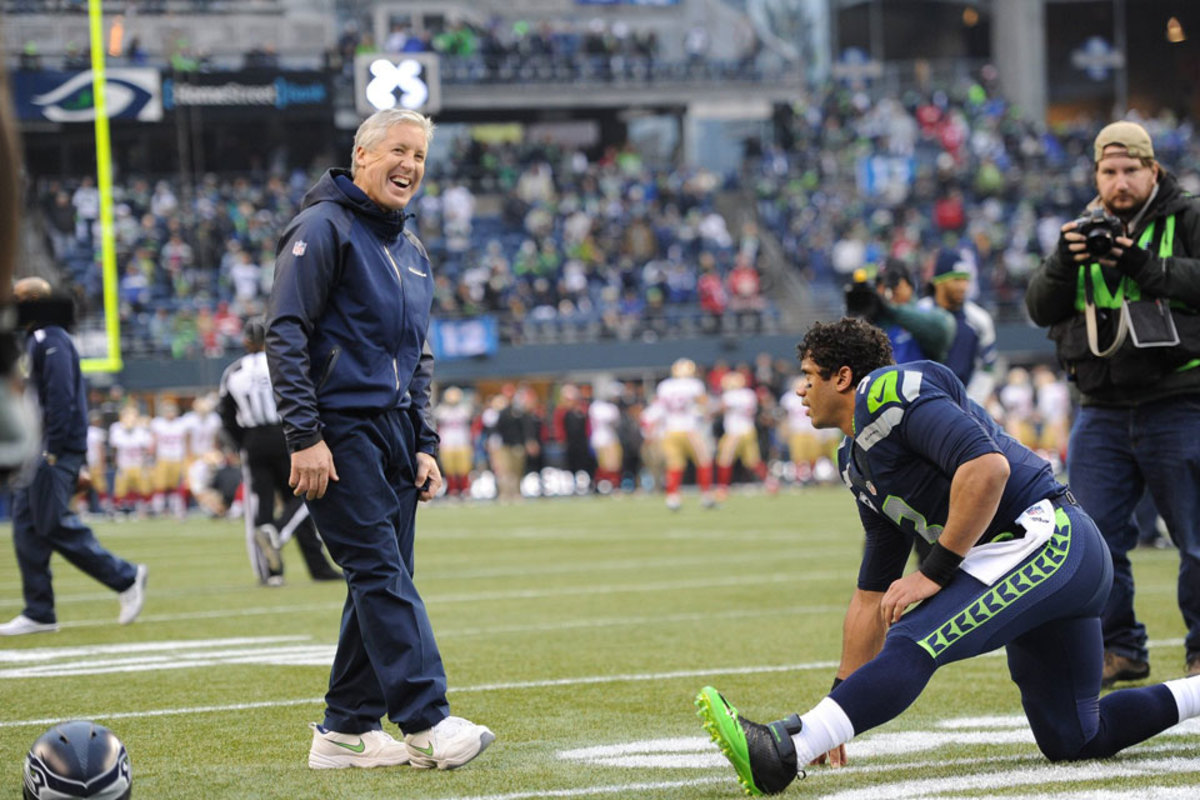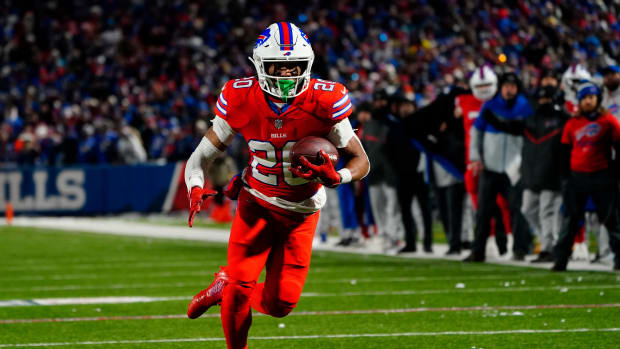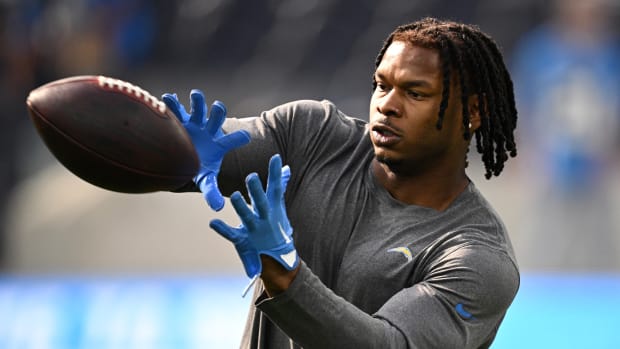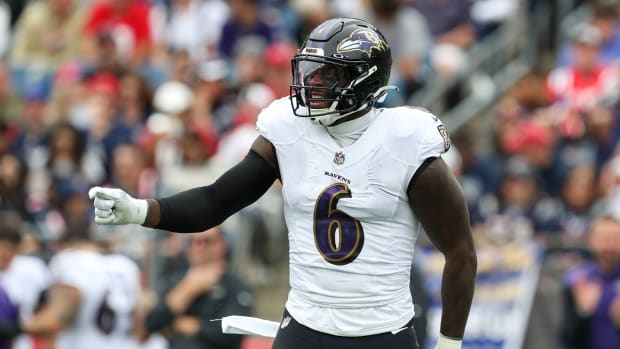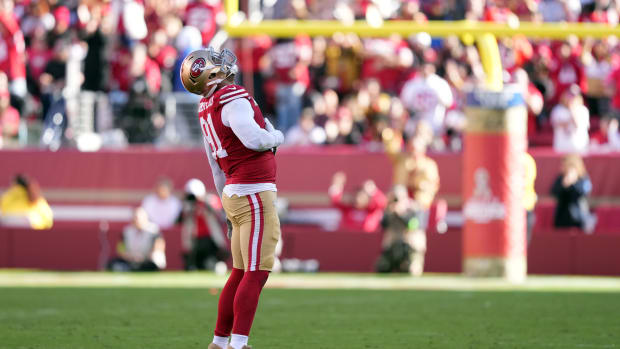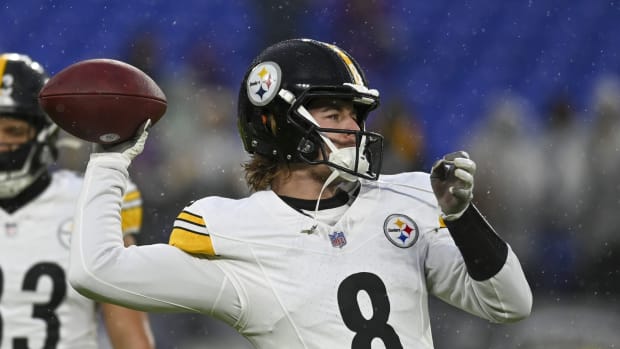The Power of Positive Coaching
SEATTLE — An hour after his Seahawks defeated the 49ers to earn a spot in Super Bowl XLVIII, Pete Carroll emerged from his office at CenturyLink Field with general manager John Schneider by his side. The two smiled and laughed as they walked slowly down a long hallway, stopping at times to pose for pictures with players, equipment staff and the George Halas Trophy, which is presented to the NFC champion.
Carroll had swapped his game attire for jeans, a button-down shirt and a heavy pullover. He was comfortable, content and surprisingly calm for someone who had taken a team that had just five wins the year before he arrived to the second Super Bowl appearance in the franchise’s 38-year history. He also was resigned to the likelihood that few people would accept that he felt neither redemption nor payback from the 23-17 victory.
Carroll was considered a failure in his previous two NFL stops. The Jets fired him after one season (1994) and the Patriots pink-slipped him after three (1997-99). He was a nice guy with a reputation for being too enthusiastic, too friendly, too positive. He was viewed as someone better suited for the rah-rah world of college, where from 2001 to ’09 he turned USC into a national power, claiming 97 victories, seven straight Pac-10 titles and two national championships in nine seasons. His approach was occasionally unconventional, which is why many people expected him to fail a third time when he said he would use the exact same philosophies with the Seahawks as he did with the Trojans.
Carroll as Jets coach in 1994 with Parcells—the man he’d follow as Patriots coach in ’97. Carroll went 6–10 in New York but had a winning record over three seasons with New England. (Winslow Townson/AP :: Jim Rogash/AP)
“I can remember being with him the day he was deciding to take the job to go to Seattle,” says Yogi Roth, a Pac-12 Network analyst who was a USC assistant under Carroll. “He had a really clear vision of how he wanted to do things and relentlessly competed to hang on to it. He refused to budge. When you’ve let go of elements of the past that are hard to deal with, and when you know yourself as well as he did at that time …”
Roth paused before continuing: “Pete told me once, ‘They already killed me once—they got me in New York and they got me in Boston—so I’m going to be me. They can’t hurt me now.’ For Pete that was a very humble way of saying, ‘I’ve been through a lot, and if I go to Seattle I’m going to do it the way that I’ve laid it out, exactly to my personality and to my philosophical approach.’ ”
For Carroll, Sunday wasn’t about proving anyone wrong. It was about proving himself right. It was about affirming that his coaching tenets—the relentless competitiveness, the constant quest to identify and maximize the uniqueness of every player and coach, the commitment to a nurturing environment that allows people to be themselves while still being accountable to the team—could work on any level, including the NFL.
Skeptics thought the rah-rah style from USC wouldn’t play in the pros. (Bob Rosato/SI)
“It’s something I came in hoping we could really demonstrate, because I really do believe this is a different way of dealing with people,” Carroll says. “It’s a way that you can help people find heights that they might not have found otherwise. There’s a lot that goes into that statement, but I believe it because I’ve watched it, I’ve seen it. I was just hoping that if the opportunity came along we’d get a chance to show it because I respect the NFL so much. It’s the hardest, most difficult, most competitive challenge to excel at. It’s special—special—to see the things we believe in working.”
Carroll has every right to thump his chest, even if he refuses to do so. He was never given a real shot in his previous NFL stops. Former Jets owner Leon Hess fired him because he wanted to hire Rich Kotite—chew on that for a second … Rich Kotite—and New England owner Robert Kraft limited his authority over personnel because he was still spooked after an internal power struggle with former coach Bill Parcells.
“In some ways I think the experience with Parcells made it more difficult for me to allow [Carroll] to have the authority he wanted here,” Kraft told The Boston Globe in 2010. “And I was definitely making sure we had checks and balances until I knew I had the right person. I’m not sure that was fair to him. He was a heck of a coach.”
The Power of Positive Coaching
A passionate presence in the Seahawks’ locker room. (Rod Mar for SI/The MMQB)
Carroll has taken the Seahawks to the playoffs in three of his four seasons. (Rod Mar for SI/The MMQB)
Players appreciate his loose style. (Rod Mar for SI/The MMQB)
Richard Sherman’s certainly on board. (Rod Mar for SI/The MMQB)
As is Russell Wilson. (Rod Mar for SI/The MMQB)
With linebacker Bobby Wagner. (Rod Mar for SI/The MMQB)
He's not afraid to chuck it around. (Rod Mar for SI/The MMQB)
Going over some pointers with Russell Wilson. (Rod Mar for SI/The MMQB)
Hugging it out with defensive end Red Bryant. (Robert Beck/SI/The MMQB)
Sharing a laugh with center Max Unger. (Robert Beck/SI/The MMQB)
Some pregame love for receiver Doug Baldwin. (Robert Beck/SI/The MMQB)
And some upbeat words for tackle Breno Giacomini. (Robert Beck/SI/The MMQB)
Getting pumped before the NFC title game. (Robert Beck/SI/The MMQB)
And during . . . (Robert Beck/SI/The MMQB)
. . . and following the clinching interception. (Pouya Dianat for SI/The MMQB)
After wondering if he’d ever get another NFL gig, Carroll is headed to his first Super Bowl. (Rod Mar for SI/The MMQB)
During his year out of football the following year, Carroll did some serious self-scouting. He asked himself what he could do better, and he reflected on the words of his mother, who often told him to treat each day as if something positive were about to happen. That mentality is contrary to the ways of the NFL, where people tend to focus on things that could go wrong. Carroll would no longer allow himself to be one of those individuals.
He also read Wooden: A Lifetime of Observations and Reflections On and Off the Court, the powerful memoir by the former UCLA basketball coach John Wooden. It resonated with Carroll not only because Wooden needed 17 years before winning his first national championship, but also because he believed in being positive and nurturing. Carroll also pulled nuggets from successful coaches whom he had worked under, like Bill Walsh, Bud Grant and George Seifert.
Ultimately he formulated a blueprint that was heavy on fun and competition and taking advantage of the uniqueness of each individual. He would have themes for each day of the week—Tell the Truth Monday, Competition Wednesday, Turnover Thursday. He would have the first-string offense and defense face off in brief unscripted scrimmages so they would be ready for things they hadn’t prepared for. He would blare music throughout practice to raise the energy level and force his players to focus and refocus amid distractions.
“I didn’t know I’d get another chance in the NFL—I didn’t think that—so that’s why I went the college route, to try to see what would happen if we applied these philosophies,” Carroll says. “Fortunately, going into SC, I was so ready to go in there. I had had a big change in my thinking and had adjusted things, so that was like the proving ground, and it worked out great. We’ve come here to Seattle and we haven’t done one thing different. It basically comes down to taking care of the people in your program and making them the best they can be—not giving up on them and never failing to be there for them. They don’t even totally know that’s how we are with them, because we do it so completely.”
It’s not all smiles: With Russell Wilson during the divisional round win over the Saints. (Robert Beck/SI/The MMQB)
In the process he has forced critics who said his way was too collegiate and corny for the NFL to rethink that.
“This lets the rest of the National Football League and the rest of the coaching world know that his philosophy works,” says fullback Michael Robinson. “You can love a guy up and [still] create an environment that’s conducive to winning. He’s the first coach to do it that way, to have a college-type atmosphere in the pros.”
“I don’t think anybody thought his system could work,” says All-Pro cornerback Richard Sherman. “It shows you can win with positivity, with having a great mindset. They say you have to be a hard coach to win in this league, but that’s not who he is. We love it.”
What’s not to love? In his four years, with the aid of astute personnel moves by Schneider, Carroll has taken the Seahawks from 5-11 the year before he arrived to 7-9, 7-9, 11-5 and 13-3. He has qualified for the playoffs three times and won at least one game in each appearance. He has tried to better not only himself, but those around him.
For instance, one of his first questions for potential hires is: Can you explain your coaching philosophy in 25 words or less? He spends a week every offseason on staff development and requires each person to make the case for why he should climb the next rung on the coaching ladder.
“He works through those details with them, and it really comes from a good-hearted place,” Roth says. “He wants to get the best out of them because then there’s a sense of ownership.”
Linebackers coach Ken Norton Jr. played with the 49ers when Carroll was the defensive coordinator there in 1995 and ’96. Norton was later was an assistant on Carroll’s staff at USC and followed him to Seattle when Carroll joined the Seahawks. Late Sunday night, after the win over the 49ers complete, he stood in the locker room in a suit and tie with a NFC Champion cap on his head. He thought about the journey that Carroll has experienced, sighed and smiled.
President Peter McLoughlin, GM John Schneider, QB Russell Wilson, cornerback Richard Sherman, coach Pete Carroll and owner Paul Allen. (Rod Mar for SI/The MMQB)
“This means everything to him,” he said. “He’s a man who really knows who he is. He understands how to let people be themselves, and he understands how to bring staffs together. You see the way he built this team in four years—fantastic leader, great mentor. To see him work day after day, his exuberance, his excitement, his energy, he never has a bad day. I think he really learned from his previous stops.”
Which begs the question, could he have accepted not having a third shot at the NFL?
“No, not at all,” Norton says. “He always wanted to get back. Competition for him is not a word, it’s a way of life. He just lives it, breathes it, every day. I don’t know if he ever said, ‘This is my chance to show people,’ but he showed it. It was his actions. He knew what he wanted to do. He knew exactly if he ever had the opportunity to do it again that he was going to do it his way—and he has.”
(Carlos M. Saavedra/SI/The MMQB)
































